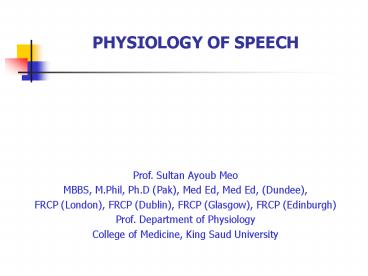PHYSIOLOGY OF SPEECH - PowerPoint PPT Presentation
1 / 24
Title:
PHYSIOLOGY OF SPEECH
Description:
PHYSIOLOGY OF SPEECH Prof. Sultan Ayoub Meo MBBS, M.Phil, Ph.D (Pak), Med Ed, Med Ed, (Dundee), FRCP (London), FRCP (Dublin), FRCP (Glasgow), FRCP (Edinburgh) – PowerPoint PPT presentation
Number of Views:1400
Avg rating:3.0/5.0
Title: PHYSIOLOGY OF SPEECH
1
PHYSIOLOGY OF SPEECH
Prof. Sultan Ayoub Meo MBBS, M.Phil, Ph.D (Pak),
Med Ed, Med Ed, (Dundee), FRCP (London), FRCP
(Dublin), FRCP (Glasgow), FRCP (Edinburgh) Prof.
Department of Physiology College of Medicine,
King Saud University
2
SPEECH
Definition Speech may be defined as the means of
communication between the two individual or
group of individuals Means of communications
Sensory Or Motor Sensory Communication Auditory
communication Visual communication Motor
Communications Power of taking writing
3
STEPS OF COMMUNICATION
Steps of Communications Collection of sensory
input Auditory and visual Integration hearing
and articulation mechanism Motor execution
4
Brain Areas Concerned with Speech / Language
- Wernicks Area
- Brocaa Area
- Speech articulation Area in Insula
- Motor Cortex
- Angular Gyrus
- Aud Assoc Areas
5
SPEECH CENTRES
Broca's Area. A special region in the frontal
cortex, called Broca's area, provides the neural
circuitry for word formation. This area, is
located partly in the posterior lateral
prefrontal cortex and partly in the premotor
area. It is here that plans and motor patterns
for expressing individual words or even short
phrases are initiated and executed. This area
also works in close association with Wernicke's
language comprehension center in the temporal
association cortex,
6
Auditory Language Perception
7
Visual Language (Reading)
8
THE SPEECH CHAIN
9
ASSOCIATION AREAS
These areas receive and analyze signals
simultaneously from multiple regions of both the
motor and sensory cortices as well as from
sub-cortical structures.
- The most important association areas are
- Parieto-occipitotemporal association area
- Prefrontal association area
- Limbic association area.
10
PARIETO-OCCIPITOTEMPORAL ASSOCIATION AREAS
1. Analysis of the Spatial Coordinates of the
Body. 2. Area for Language Comprehension. 3.
Area for Initial Processing of Visual Language
(Reading). 4. Area for Naming Objects.
11
PRIMARY, SECONDARY AND ASSOCIATION AREAS
12
SPEECH PRODUCTION PROPCESS
13
APHASIA
CATEGORICAL HEMISPHERE
APHASIA IS LOSS OF OR DEFECTIVE LANGUAGE FROM
DAMAGE TO THE SPEECH CENTRES WITHIN THE LEFT
HEMISPHERE.
PLEASE NOTE THAT
IN APHASIA THERE IS NO DAMAGE TO VISION, HEARING
OR MOTOR PARALYSIS.THE DAMAGE IS IN SPEECH
CENTERS IN CATEGORICAL HEMISPHERES
14
APHASIA
EXPRESSIVE
RECEPTIVE
NON FLUENT Understanding normal but Voice
production defective
BROCA'S AREA
WERNICKS AREA CONDUCTION APHASIA
FLUENT Meaningless words with loss of
comprehension / understanding
ANOMIC Unable to name the objects
ANGULAR GYRUS
WIDESPREAD DAMAGE TO SPEECH AREAS
GLOBAL Mixture of all
15
AREA LESION FAETURES
Auditory association areas Word deafness
Visual association areas Word blindness called dyslexia
Wernicke's Aphasia Unable to interpret the thought
Broca's Area Causes Motor Aphasia
Global Aphasia Unable to interpret the thought Motor Aphasia
16
ARTICULATION
- Means the muscular movements of the mouth,
tongue, larynx, vocal cords - Responsible for the intonations, timing, and
rapid changes in intensities of the sequential
sounds.
17
MECHANISM OF ARTICULATION
18
MECHANISM OF ARTICULATION
19
DYSARTHRIA
DYSARTHRIA MEANS DISORDER IN ARTICULATION e.g.,
SLURRED SPEECH Dysarthria disturbances of the
articulation in which contents of speech
(Language) is unaffected In some individuals who
has no abnormality in the speech centre or in its
pathways results in stuttering speech
20
DYSARTHRIA
DISORDERED ARTICULATION
- Slurred speech.
- Language is intact, aphasia.
- Paralysis, slowing or in coordination of muscles
of articulation or local discomfort causes
various different patterns of dysarthria. - Examples
- gravelly' speech of upper motor neuronal lesions
of lower cranial nerves, - jerky, ataxic speech of cerebellar lesions
(Scannimg Speech), - the monotone of Parkinson's disease (Slurred),
- speech in myasthenia that fatigues and dies away.
Many aphasic patients are also somewhat
dysarthric.
21
STUTTERING
- Have right cerebral dominance and widespread
overactivity in the cerebral cortex and
cerebellum. This includes increased activity of
the supplementary motor area.
22
PHONATION
- Sound production by passage of air over the vocal
cord. - Dysphonia Abnormal sound production due to
problem in vocal cord e.g., paralysis, CVA, other
causes - Causes Paralysis of both vocal cord e.g
whispering sound and inspiratory strider - Paralysis of left vocal cord The voice becomes
week and cough bovine. Mainly due to recurrent
laryngeal palsy
23
GLOBAL APHASIA (CENTRAL APHASIA)
This means the combination of the expressive
problems of Broca's aphasia and the loss of
comprehension of Wernicke's. The patient can
neither speak nor understand language. It is due
to widespread damage to speech areas and is the
commonest aphasia after a severe left hemisphere
infarct. Writing and reading are also affected.
24
THANK YOU































